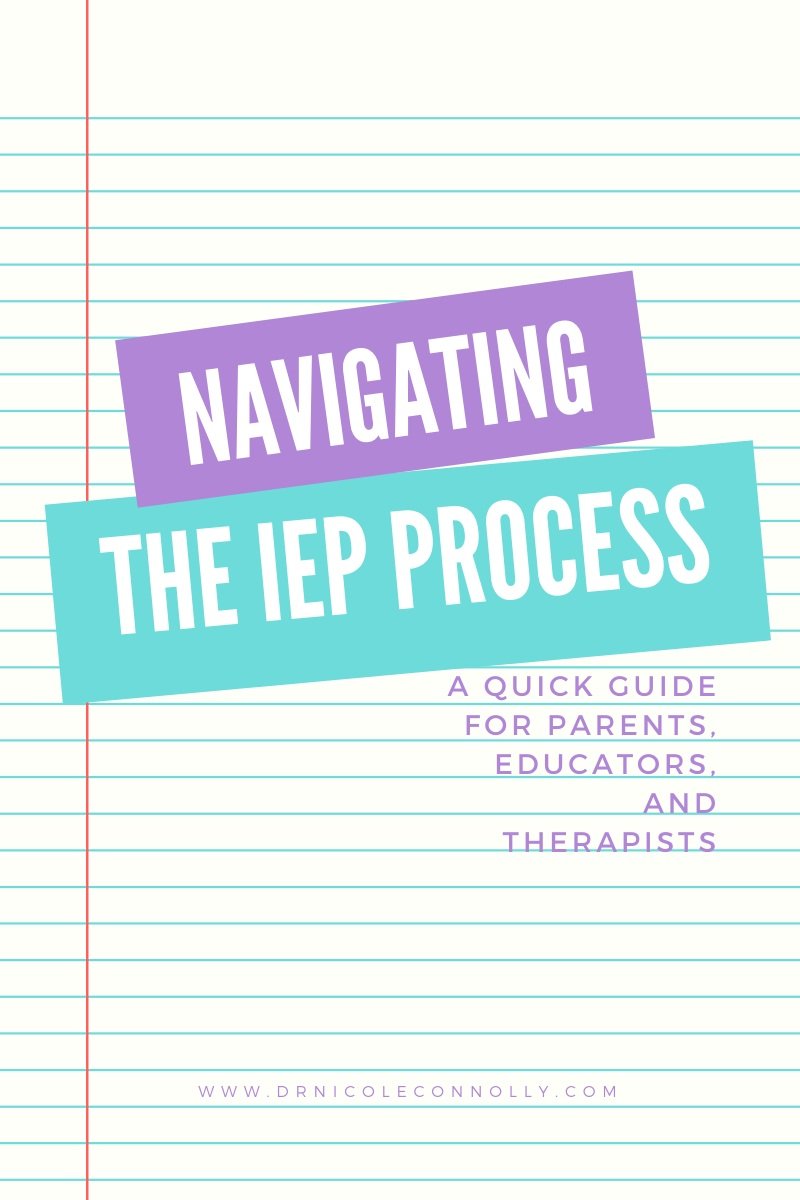Navigating the IEP Process - A Psychologist’s Perspective
If you are reading this post, then likely you either have concerns about a child in your life or you work in a profession focused on helping kids succeed. Navigating the Individualized Education Program (IEP) process can be a daunting but necessary journey for parents, therapists, and educators. The IEP serves as a crucial roadmap for students with disabilities, outlining their personalized educational goals, helpful accommodations, and services tailored to meet their unique needs.
However, understanding the intricacies of this process, advocating effectively for your child, and collaborating with school personnel can feel very overwhelming, especially when you are new to this process. In this blog post, we'll delve into strategies and insights to empower families and educators in navigating the IEP process with confidence and clarity, ensuring every child receives the support they deserve to thrive academically and beyond.
What is an IEP?
In short, “IEP” stands for Individualized Education Plan. Under the IDEA act - a.k.a. "No Child Left Behind" - schools are required to provide accommodations to children with specific types of disability that interfere with their ability to “access their educational curriculum.” What this means is that your public school is required by law to assess what may be interfering with your child’s ability to learn in school and then provide accommodations and services to help your child learn more effectively.
Basically, an IEP is a legally binding document outlining the challenges your child is having in school, the specific goals that staff have for their improvement, and the required services that the school will give to your child to help them succeed. This document is created through the IEP process, which involves several steps.
Which children qualify for an IEP?
The No Child Left Behind Act outlines different qualifying reasons that a child may need an IEP. These include issues like learning problems, speech-language impairments, autism, mental health problems, or other health impairments like chronic illnesses or physical disabilities. Children must demonstrate symptoms consistent with one of the qualifying categories in order to receive an IEP.
So what if you think your child may need an IEP?
For parents of children who are beginning to struggle in school, getting assistance can be a daunting proposition. If your child is struggling with learning problems, behavioral issues, or other struggles that interfere with successfully participating in the classroom, then requesting an assessment from your school may be helpful.
An IEP evaluation can be requested by parents in writing or can be initiated by your child’s teacher. Many parents start with discussions with their child’s teacher, but you can also request an assessment by sending a letter to your school’s administration directly.
Sometimes schools may want to start with a Student Success Team (SST) meeting to try to solve the problems informally. For kids whose struggles are mild or temporary, this can be a good solution. However, if your child has been struggling for a while or if they have a medical diagnosis from their pediatrician or therapist, then an IEP or 504 plan may be a better option.
What does the IEP process look like?
IEP individualized education plan timeline by Nicole Connolly, Ph.D., Santa Clarita Psychologist
To help parents, therapists, and other stakeholders understand the IEP process a bit better, we have created this infographic to help deconstruct the process.
Once a referral for an evaluation has been made, the school will send parents a plan for the evaluation and a form to sign to provide consent. It’s important to return this as soon as possible to help get things going as quickly as possible for your child.
Once the plan and informed consent are in place, the school psychologist and other professionals will conduct an evaluation of your child. These evaluations may include psychological testing, questionnaires, or assessments by speech pathologists and occupational therapists.
After the evaluation is done, the school will schedule an initial IEP meeting. At the meeting, the school psychologist and other professionals will share their assessment results and discuss plans for helping your child. Your child’s classroom teacher, a special education teacher, and an administrator will also likely be present at the meeting.
If you agree with the plan discussed at the meeting, you will be given a copy of the IEP to sign. Once signed, the school will begin providing the services outlined in the IEP to your child. Schools are required to hold an annual meeting to review the current IEP and create a new one for the following year. Parents are also allowed to call an IEP meeting any time they want to discuss concerns or a change in services.
Please note that the times indicated are generally considered the maximum allowable number of school days for each part of the process here in Santa Clarita, California. It’s really important to point out that school days are only counted on days that the school is in session. If your IEP process includes the summer or school breaks, your timeline may vary. This is intended to give a general guide for the maximum amount of time each step *should* take. If you have concerns about the length of time your process is taking, consult with your district or a special education advocate in your area.
Resource for The IEP Process
For more information on the IEP process, the following websites may be helpful.
General information:
Overview of IEPs from NICHCY
IEP information from Wrightslaw.com
IEP information from ThoughtCo.com
California-specific information:
Guide to the IEP Process by Disability Rights California
When do you need an outside psychologist in the IEP process?
If you are concerned about your child's behavior or lack of progress in school, consulting with a child psychologist or therapist privately can also be incredibly helpful for better understanding your child and developing a plan for addressing the problems. An outside psychologist or therapist can help support you through the IEP process and help you advocate more successfully for your child.
Through the IEP process, you will discover the needs of your child. However, sometimes you may need an outside professional to help provide an official diagnosis for your child. While the school psychologist may do a lot of testing, they are not allowed to provide a specific diagnosis. A private psychologist can provide further assessment and diagnosis for the IEP process or for other services.
Even with an IEP, your child still may need therapy. Schools aren’t always in the business of treating mental health issues in children. The IEP is there to help your child access their education. Beyond having a psychologist to help with diagnosis, some children need a private psychologist or therapist to help treat mental health issues that create issues outside of school as well. For example, if a child has anxiety and OCD, the IEP may help them with tools to improve their grades, but a private psychologist is going to treat the anxiety and OCD directly through psychotherapy.
Getting help with your IEP in Santa Clarita, CA
If you are in the Santa Clarita area or anywhere in the state of California, we can help! We specialize in supporting families who are just starting the IEP process and in supporting families who are struggling with IEPs that are not functioning well. We excel in providing compassionate, evidence-based care to children whose mental health concerns are getting in the way of learning at school. To learn more about we can help, whether in person or virtually, just click here for a free brief consult.


